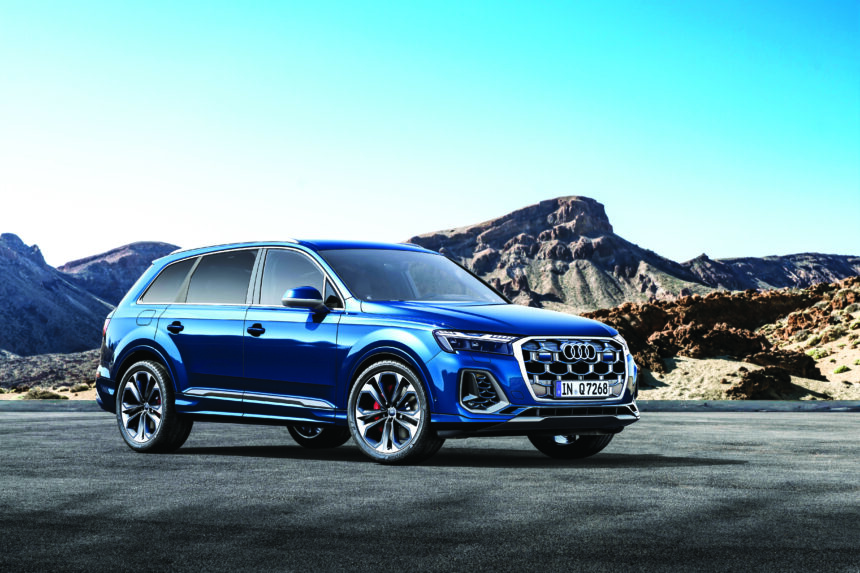Audi has once again upgraded its flagship Sport Utility Vehicle (SUV) with a clear visual language and even better technology.
The fresh exterior design with new front and rear sections underscores the powerful character of the SUV, which offers first-class versatility and generous space for up to seven passengers.
For the first time in a Q7, the High Definition (HD) Matrix Light-Emitting Diode (LED) headlights include laser as an additional high beam, along with sport digital daytime running lights that offer selectable light signatures.
Digital Organic LED rear lights with four selectable light designs complete the offering.
New wheels, colours, decorative inlays and seats with contrast stitching lend the
Q family’s most versatile SUV an even higher level of customisability.
Audi’s latest Q7 journey of success began in 2003 as a concept car called the Audi Pikes Peak quattro.
Conceived as a vehicle suitable for driving on all roads and moderate off-road use, the Q7 has been delighting customers worldwide for 18 years.
It remains true to its virtues of design, technology and functionality.
The first SUV from the brand with the four rings was unveiled to the public at the 2005 Frankfurt Motor Show (Internationale Automobil-Ausstellung) – just in time for the 25th anniversary of the quattro permanent four-wheel drive system.
The new “superlative” in the SUV segment, as Audi put it at the launch of the Q7, combined poise, sportiness and versatility.
Since its launch, the Audi Q7 has been viewed as an all-rounder that combines high prestige with a wide range of applications.
The exterior
Following the launch of the second generation with all-wheel steering in 2015 and an initial product upgrade in 2019, the new Q7 impressively shows its robust and elegant design with this second, comprehensive upgrade.
With its even more minimalist form, clean surfaces and exceptionally large volume, the Q7 stands for adaptability in every situation. The overhangs and wheelbase demonstrate powerful and confident proportions that are further emphasised by distinctive exterior colours and wheels.
The unmistakably upright Audi Singleframe with an octagon design now boasts vertical inlays.
This makes it clear at first glance that the vehicle is an Audi top model, and differentiates it from the A models.
In addition, the new interplay between the grille’s contours and the headlights, now positioned slightly higher, makes for a completely new front-end architecture that clearly emphasises the powerful and more present appearance of the new Q7.
The Q7’s self-confident appearance is underscored by the new prominent, colour-framed air intakes, which are integrated into the vehicle’s basic architecture.
Suspension with Audi’s DNA
Only an Audi drives like an Audi: This is how the brand with the four rings sums up the DNA of Audi’s on-road characteristics, and it is no less true for the Q7.
Five characteristics define the Q7’s handling: balanced, solid, controlled, precise and effortless. The suspension, steering, drive, braking and control systems all play a key role in creating a reliably safe, confident and comfortable driving experience.
Electronically-controlled air suspension with a continuously adaptive damping system – adaptive air suspension or adaptive air suspension sport (standard equipment on the SQ7 Turbocharged Fuel Stratified Injection (TFSI) – are included.
Depending on the driver’s preferences and the driving situation, the suspension adjusts the ride height by up to 90 millimetres (mm) while also offering level control.
On the highway, the suspension lowers automatically by up to 30mm, depending on the current speed – and by 15mm with adaptive air suspension sport.
During off-road driving, the ‘Lift’ function in Audi drive select can be used to increase the ground clearance by up to 60mm at low speeds.
In addition, all-wheel steering (standard equipment on the SQ7 TFSI) ensures an increased level of safety and comfort.
At low speeds, the back wheels turn up to five degrees in the opposite direction to the front wheels.
This reduces the turning radius by up to one metre and increases manageability.
At the same time, the driver feels more comfort and stability at higher speeds because the back wheels turn in the same direction as the front wheels.
Drive systems
The range opens with the Q7 55 TFSI featuring a six-cylinder petrol engine
with three litres of displacement and direct fuel injection that delivers 250 kilowatts (kW).
It produces a maximum torque of 500 Newton-metres in a broad rev range from 1 370 to 4 500 revolutions per minute.
The Audi Q7 55 TFSI accelerates from zero to 100 kilometres per hour (km/h) in 5.6 seconds.
It reaches its electronically-governed top speed at 250km/h.
The interior
Both the five- and seven-seat versions of the Audi Q7 and SQ7 TFSI combine high prestige with everyday practicality.
With their generous length, headroom and elbowroom front and back, both vehicles offer a first-class, airily spacious atmosphere. Depending on the position of the rear backrests, the luggage compartment in the five-seat version offers a volume of between 867 litres (backrests up) and 1 993 litres (backrests down).
The tailgate is electrically powered as standard.


